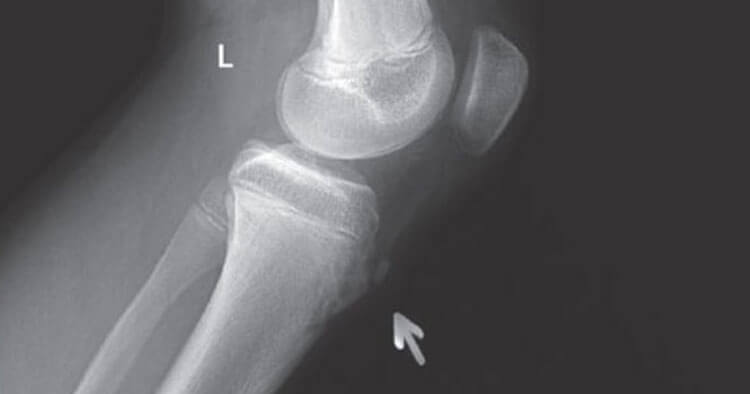Muscle Pain and Tendinopathy, Sports Injuries and Management
Osgood Schlatter’s Disease Is Not Really A Disease
What Is Osgood Schlatter’s Disease?
Osgood Schlatter’s Disease, frequently referred to just as Osgood Schlatter’s, is a common cause of knee pain in growing adolescents. The basic anatomy of the area is that at the front of your thigh your quadriceps muscles attach to the shin bone, just below the knee cap via a thick tendon called the patella tendon. At the point of attachment of the patella tendon to the shin bone is a noticeable visually bony bump called the tibial tuberosity which is the site of pain in this condition.
Note: Osgood Schlatter’s Disease is not really a disease, it is more of a “syndrome” that is related to the abnormal growth of the tibial tuberosity (the attachment point for the quads via the patella tendon ).
Growth Spurts And High Activity Levels
In Osgood Schlatter’s Disease it is thought to be the abnormal growth of this tibial tuberosity that causes the pain, where the condition frequently occurs around a period of growth. Growth spurts and high physical activity are commonly associated with the development, or exacerbation of this type of knee pain, henceforth Osgood-Schlatter’s is a common cause of knee pain in children particularly between the ages of 10-14 years. The condition is more common in boys, most likely this is to do with the varied stages of hormonal changes between boys and girls at this stage of adolescence and any resulting varied growth changes, coupled with the tendency that historically boys around this age are more active than girls of the same age. When someone has Osgood Schlatter’s Disease the tibial tuberosity may visually appear swollen and is painful to touch, as well as causes discomfort during activities such as running, jumping, kneeling, stair climbing…
What Makes Kids Different?
Due to the rapid rate at which kids can grow, their muscles, tendons and ligaments may grow at different rates to their bone. The relative strength of muscles in relation to the size of their body (skeletal system) that they are growing into may not be balanced. In some children it may take months, even years for their growing body to ‘catch up’ to where it needs to be, the point where their body can support its size, taking years to reach the point where the bones and soft tissues that help support them are in balance and enable them to function and operate in a more biomechanically ideal state. With such changes in the size of bones, muscles, and tendons and other soft tissues through periods of rapid growth as occurs during adolescence it can carry with it dysfunctions and injuries, Osgood Schlatter’s disease is one such condition.
Causes Of Osgood Schlatter’s Disease
Osgood Schlatter’s disease is firstly related to growing fast, or a specific growth spurt. As previously mentioned the condition tends to affect adolescent children, with boys often aged about 13 to 14 years being the most impacted, and girls less affected and more likely to experience symptoms when aged 10 – 11 years old.
Some of the listed causes of Osgood Schlatter’s may include:
- Gender: As a rule boys are more susceptible than girls, but this may be because boys typically engage in more vigorous sports than girls. As mentioned above the age with which each sex experiences their symptoms varies, this is down to the developmental stages and generally girls going through a period of significant growth earlier in life than boys.
- Exercise: Active children are more at risk, particularly those engaged in athletics and sports that involve a high load with regard to running and jumping movements.
- Muscle tightness, muscle imbalances and poor postural / biomechanical alignment may also be risk factors for developing Osgood Schlatter’s.
- Injury: It is suggested that around half of all children with Osgood Schlatter’s disease report a prior knee injury to the onset of the condition, this may be as simple as a knock to the front of the knee through a fall or impact injury playing sport where the tibial tubercle is knocked triggering a flare up of pain.
Symptoms Of Osgood Schlatter’s Disease
Symptoms of Osgood Schlatter’s disease depends on the severity of the condition but is firstly recognized by the kid having pain located to the tibial tuberosity (the bony growth below the knee). This pain may be accompanied with a visually swollen tibial tuberosity as well as red and inflamed skin over the area. The condition may present in one, or both knees and if severe and persistent enough it may even lead to the individuals quadriceps muscles losing strength and size due to pain subsequent disuse.
- Pain associated may be dull at rest and sharp on activity, kids will normally complain of pain when running, jumping, going up and down stairs.
- Kneeling on the area is normally painful, as is the area getting bumped or knocked during activity.
- Kids may even have discomfort when straightening the knee joint and doing squatting movements using the quadriceps as the muscle ultimately pulls on the angry tibial tubercle.
Disclaimer: Sydney Physio Clinic does not endorse any treatments, procedures, products mentioned. This information is provided as an educational service and is not intended to serve as medical advice. Anyone seeking specific advice or assistance on Osgood Schlatter’s Disease Is Not Really A Disease should consult his or her general practitioner, physiotherapist or otherwise appropriately skilled practitioner.


